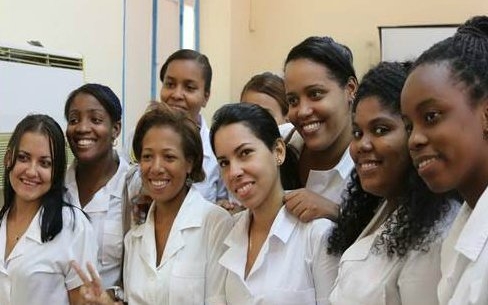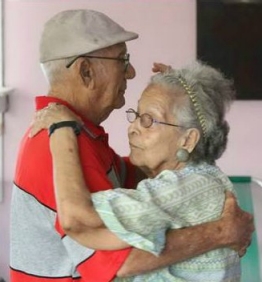
Field notes: What Cuba can teach us about building a culture of health
How is this Culture of Health so deeply woven into Cuban society? For starters, the resources for maintaining health are free, universal, and available in every community. The central government views education, housing, public safety, and other national issues all through the lens of health. At a middle school, for example, students learn about nutrition and medicinal herbs along with physics and chemistry. Not far from our hotel in Havana, some streets were unpaved and buildings were in serious disrepair—yet the government had installed new pedestrian and vehicle countdown lights at crossings. When we asked why, we were told that there had been a lot of accidents on the road, so putting a system in place that lets pedestrians know they have 10 seconds left to safely cross the street is considered a good investment in public health.
Cuba’s health care system is not perfect. Medical records are still all paper, medicines are not always easy to come by, and people can wait a long time for dental and other care. But despite having few economic resources, the Cuban government has an effective system in place for offering its residents support at the community level for maintaining and improving their health.
Here then are some lessons we believe could hold the greatest potential for catalyzing innovations in health care and population health, especially in marginalized or poor communities in the United States.
Primary Care is local and comprehensive. A physician and nurse live and work in each community, and care for about 1,800 families. They make yearly home visits and keep updated records on each member of a household to see how they are maintaining their health. If a resident needs to see a specialist, his or her records are hand-delivered back to the primary care provider. Local doctors and nurses also understand the social situation of their patients—what their homes are like, their education level, the number of family members, and any particular challenges they face. In Cuba, prevention of such public health threats as tuberculosis, diabetes, hypertension and HIV is a primary goal for the country’s leadership. This kind of continuous, cradle-to-grave medical and social care goes a long way toward helping people stay healthy and avoid hospitalization.
 There is a strong emphasis on healthy aging. Cuba has a rapidly aging population, and by 2025 one-quarter of the nation’s citizens will be over 60. Since almost all of the older people in Cuba live with their families, nursing homes are rare. To better care for older residents, local health workers educate families about how to prevent falls and how to recognize problems that need prompt care. Communities also have vibrant senior centers that offer activities that include visits to museums, dancing at local cabarets, and educational sessions where older people learn new skills and continually expand their knowledge. Since having several generations living in the same home can cause tensions, we heard about seniors taking classes on grandparenting, the challenges of intergenerational relations, elder abuse and gender equity. These senior centers are operated very much peer-to-peer, tapping the talents of the older people themselves to provide social, emotional and intellectual support. Maintaining the health of the body and mind through life-long learning is considered of upmost importance for the oldest residents of communities.
There is a strong emphasis on healthy aging. Cuba has a rapidly aging population, and by 2025 one-quarter of the nation’s citizens will be over 60. Since almost all of the older people in Cuba live with their families, nursing homes are rare. To better care for older residents, local health workers educate families about how to prevent falls and how to recognize problems that need prompt care. Communities also have vibrant senior centers that offer activities that include visits to museums, dancing at local cabarets, and educational sessions where older people learn new skills and continually expand their knowledge. Since having several generations living in the same home can cause tensions, we heard about seniors taking classes on grandparenting, the challenges of intergenerational relations, elder abuse and gender equity. These senior centers are operated very much peer-to-peer, tapping the talents of the older people themselves to provide social, emotional and intellectual support. Maintaining the health of the body and mind through life-long learning is considered of upmost importance for the oldest residents of communities.
Community health is everyone’s concern. Clinical records are used to monitor the health of the entire community. If there is an uptick in the number of skin rashes, authorities will look at water quality. If an outbreak of food poisoning occurs, the community will make sure refrigeration is adequate. When red flags go up, there is a coordinated response and intervention. For example, if residents are concerned about increased use of alcohol among their teens, community members will get together and try to develop a strategy for dealing with the problem—perhaps providing more teen activities and a space for young people to socialize. The community then informs the central public health administration about their experience with teen drinking to help the government devise a national plan for dealing with the issue, likely to be impacting other communities.
In the end, our overall impression is that the government and the people of Cuba truly value health and well-being, and are effectively building a Culture of Health. What is astonishing to us is that they have done this with the scarcest of resources. With a life expectancy of 76.9 years, Cuba is just behind the U.S., yet its spending per person on health care is about 1/25th the spending of the U.S.
From our firsthand experience, we can see real benefit in identifying best practices in other countries, including poorer or less-developed ones, and adapting them to improve social determinants of health in underserved communities in the United States—part of our strategy for global learning. The Cuban emphasis on primary care, its integration of public health and health care systems, active engagement of families and communities, and building cross-sector alliances for health, are all key elements in RWJF’s own vision.
(From the: RWJF)

